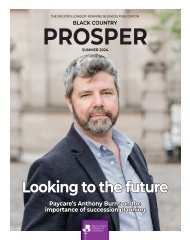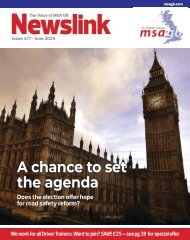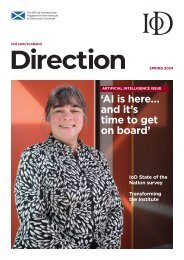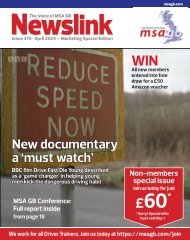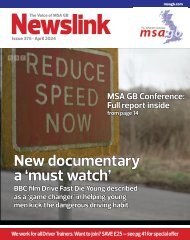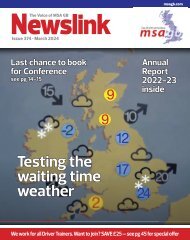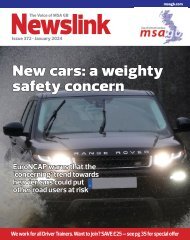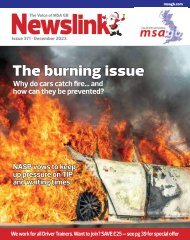Newslink January 2022
Motor Schools Association of Great Britain, driving instructors, ADIs, driver training and testing, road safety
Motor Schools Association of Great Britain, driving instructors, ADIs, driver training and testing, road safety
Create successful ePaper yourself
Turn your PDF publications into a flip-book with our unique Google optimized e-Paper software.
News<br />
Highway Code changes<br />
Continued from page 9<br />
[New] Rule 73 (continued)<br />
At junctions with no separate cyclist<br />
facilities, it is recommended that you<br />
proceed as if you were driving a motor<br />
vehicle (see Rules 170 to 190). Position<br />
yourself in the centre of your chosen lane,<br />
where you feel able to do this safely, to<br />
make yourself as visible as possible and to<br />
avoid being overtaken where this would<br />
be dangerous. If you do not feel safe to<br />
proceed in this way, you may prefer to<br />
dismount and wheel your bike across the<br />
junction.<br />
Colin Lilly writes: During the consultation<br />
some proposed that these new rules be<br />
made clear to other road users who may<br />
think that the cyclists are merely hogging<br />
the road. The advice given to drivers<br />
relating to cycle lanes and tracks has<br />
also been updated to, among other<br />
things, give advice on prioritising cyclists<br />
when crossing these lanes.<br />
Rule 140<br />
Cycle lanes and cycle tracks. Cycle<br />
lanes are shown by road markings and<br />
signs. You MUST NOT drive or park in a<br />
cycle lane marked by a solid white line<br />
during its times of operation. Do not drive<br />
or park in a cycle lane marked by a<br />
broken white line unless it is unavoidable.<br />
You MUST NOT park in any cycle lane<br />
while waiting restrictions apply.<br />
You should give way to any cyclists in<br />
a cycle lane, including when they are<br />
approaching from behind you – do not<br />
cut across them when you are turning or<br />
when you are changing lane (see Rule<br />
H3). Be prepared to stop and wait for a<br />
safe gap in the flow of cyclists before<br />
crossing the cycle lane.<br />
Cycle tracks are routes for cyclists that<br />
are physically protected or located away<br />
from motor traffic, other than where they<br />
cross side roads.<br />
Cycle tracks may be shared with<br />
pedestrians.<br />
You should give way to cyclists<br />
approaching or using the cycle track<br />
when you are turning into or out of a<br />
junction (see Rule H3). Be prepared to<br />
stop and wait for a safe gap in the flow<br />
of cyclists before crossing the cycle track,<br />
which may be used by cyclists travelling<br />
in both directions.<br />
Bear in mind that cyclists are not<br />
obliged to use cycle lanes or cycle tracks.<br />
MSA GB Conclusion:<br />
This is the most extensive rewrite of<br />
the Highway Code for some time and an<br />
idealist may say it is essential reading for<br />
all road users, but realistically I know<br />
this is unlikely to happen.<br />
An AA survey of its members at the<br />
end of last year found that two out of<br />
three were unaware that changes to the<br />
Highway Code were imminent – and<br />
one-in-five thought it was ‘fake news’.<br />
Our learners will no doubt face<br />
opposition from other drivers who are<br />
unaware of the changes, or not accepting<br />
of them.<br />
Those working with qualified drivers<br />
may need to not only update knowledge<br />
but adjust some attitudes.<br />
The underlying message is that the car<br />
is no longer king and that a republic has<br />
been declared.<br />
Concern as public unaware of major changes<br />
The major changes to the Highway Code<br />
risk failing to boost safety because they<br />
have not been promoted widely enough,<br />
campaigners have warned.<br />
Charity Cycling UK called for a “longterm<br />
and well-funded communications<br />
campaign” to make people aware of the<br />
update.<br />
The Department for Transport insisted<br />
it will ensure “all road users are aware”<br />
of what is happening.<br />
There will also be a recommendation<br />
for car users to reduce the risk of opening<br />
a door into the path of a cyclist by using<br />
the hand on the opposite side to the<br />
door, as this will often lead to them<br />
looking over their shoulder – known as<br />
the ‘Dutch Reach’ technique.<br />
But Cycling UK’s Duncan Dollimore<br />
said the revisions to the Highway Code<br />
“are not being communicated”, and “will<br />
be of limited benefit if the public aren’t<br />
aware of them”.<br />
He said: “Many people won’t have<br />
read the Highway Code for years so it’s<br />
essential that the key changes are clearly<br />
explained, with simple, accurate and<br />
memorable messages.<br />
“Just as we saw with the introduction of<br />
other road safety measures like mandatory<br />
seat belts and stricter drink driving laws,<br />
the public needs to be accurately<br />
informed about the new rules.<br />
“The hierarchy of responsibility and<br />
changes to junction priority need to be<br />
explained and communicated properly.”<br />
Steve Gooding, director of motoring<br />
research charity the RAC Foundation,<br />
agreed that a “major communications<br />
exercise” was needed “to draw attention<br />
to, and explain, the new system”.<br />
He warned: “Millions of people who<br />
have been driving for a long time won’t<br />
have looked at the existing Highway<br />
Code for years, if not decades.<br />
“What are the chances they’ll read an<br />
updated version?<br />
“The changed guidance relating to the<br />
priority to be given at junctions has the<br />
potential to be confusing.<br />
“Knowing that you had the right of way<br />
according to the new code is going to be<br />
little comfort if you’re the one who ends<br />
up getting hurt.”<br />
10<br />
NEWSLINK n JANUARY <strong>2022</strong>






